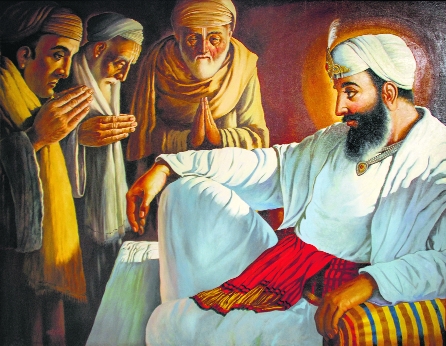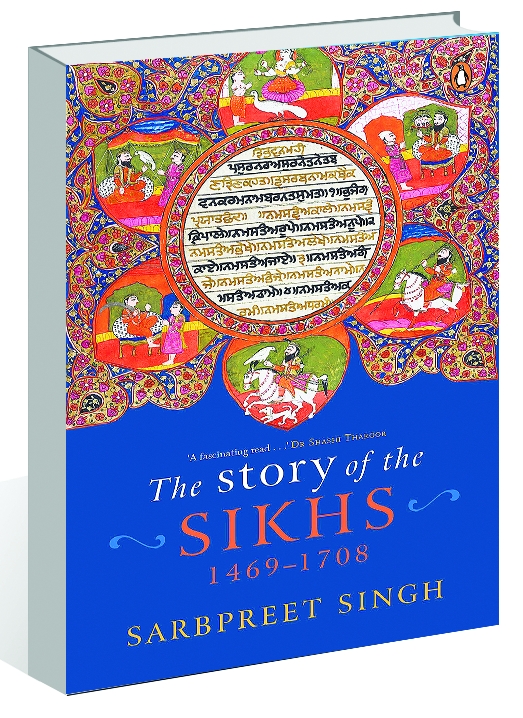The Story of The Sikhs: 1469-1708 by Sarbpreet Singh. Penguin Random House. Pages 428. Rs899
Book Title: The Story of The Sikhs: 1469-1708
Author: Sarbpreet Singh
Mohinder Singh
“I bring from the East what is practically an unknown religion.” This is what celebrated author Max Arthur Macauliffe wrote in the Preface to his magnum opus, ‘The Sikh Religion: Its Gurus, Sacred Writings and Authors’, first published in 1909. While the Sikhs are no longer unknown to the West because of the universal message of the Sikh religion and worldwide disbursal of its followers, they remain victims of bias because of ignorance of the host society about their faith and symbols of their identity. This became obvious during attacks on members of the Sikh community because of mistaken identity after the bombing of the Twin Towers in New York on September 11, 2001. There is therefore need to produce authentic literature about the Sikhs and their faith written in the language and idiom of the Western society. In this context, Sarbpreet Singh’s ‘The Story of the Sikhs (1469-1708)’ is a welcome addition to the extant literature on the subject.

Sarbpreet Singh does not need any introduction. He has already established his credentials as an author of the critically acclaimed ‘Night of the Restless Spirits’ and ‘The Camel Merchants of Philadelphia’. Based on traditional Sikh sources and Western writings, Sarbpreet weaves the story of Sikhism from Guru Nanak to Guru Gobind Singh. The pioneering effort of Guru Nanak in awakening the masses from their slumber through his soul-stirring hymns, set to music by Bhai Mardana, is beautifully described by Allama Iqbal: “Again from Panjab the call of monotheism arose. A perfect man roused India from its slumber.”
Sarbpreet describes in detail the travels of Guru Nanak in different parts of India and neighbouring countries and the lasting impact they had on those who came in contact with the Guru. Worth mentioning is Guru Nanak’s encounter with Sheikh Sajjan, during his visit to Tulamba, who operated in the guise of a welcoming friend but in reality was a cheat. Sensing his host’s intentions, the Guru started singing rather than going to sleep. It is said that the hymn recited by the Guru transformed Sajjan’s life and his house became the first Dharamsal (later known as gurdwaras). Sajjan was tasked to preach Guru’s message — ‘Kirt karo, naam japo, wand chhako’ (engage in honest labour, recite the Name of God and share what you have).
While discussing martyrdom of the fifth Guru, Arjan Dev, the author has done well in quoting from Emperor Jahangir’s memoirs, ‘Tuzk-e-Jahangiri’, and Portuguese letters, which throw fresh light on the subject. Similarly, he has gone deep into the sources on the martyrdom of Guru Tegh Bahadur. Travels of the Guru to Malwa, Bangar and Puadh areas of Punjab and the works of welfare such as digging of wells, baolis and tanks, created the much-needed sources of water in this barren land. This earned the Guru the gratitude of Jat tribes, who entered the Sikh fold en masse. The sturdy peasantry of Malwa was given a mission by the Guru — Fear not, Frighten none — and posed a danger to the system, which was unjust. Aurangzeb, who was already feeling restive over rising of the Satnamis — a sect comprising peasants, artisans and untouchables — was alarmed at this development and thought of putting an end to the growing popularity of the Guru and ordered his execution along with his trusted companions. Martyrdom of Guru Tegh Bahadur is thus described by his son and successor Guru Gobind Singh:
Dharam het saakaa jin keeaa ||
Sees dheeaa par sirar na dheeaa ||
For righteousness he did this deed
Laid down his head but not his creed
The mission of Guru Nanak for creating a just social order was completed by Guru Gobind Singh and announced to the beat of the nagaara at Anandpur on the Baisakhi of 1699 with the creation of the Khalsa.
While the author has provided lucid accounts of the lives of the Gurus and quoted interesting anecdotes and legends, he has not provided footnotes for the sources he has consulted. For instance, on page 277, he writes, “A Muslim Saint Pir who happened to be there at the time of the execution proclaimed: ‘The Emperor’s actions are unjust and improper. Mark my words! A great rebellion that will destroy the city of Delhi is coming.’” This is an important account about ‘some Pir’ trying to intervene in saving the life of the Guru and making a prophetic statement. But the author does not provide us with the name of the Pir and the source of his information.
The author will also do well if in the revised edition he does not include long passages from Punjabi classics with transliteration and English translation, which in some cases run into two-three pages and distract the reader from the narrative. Similarly, Bibliography of primary and secondary sources should be added.














